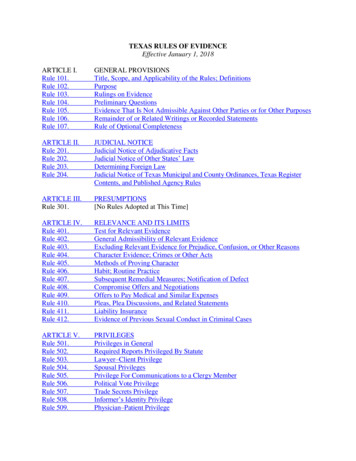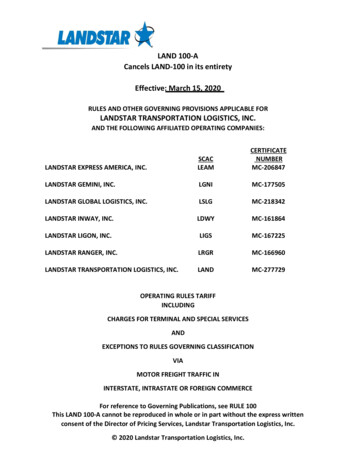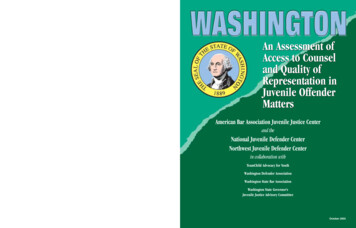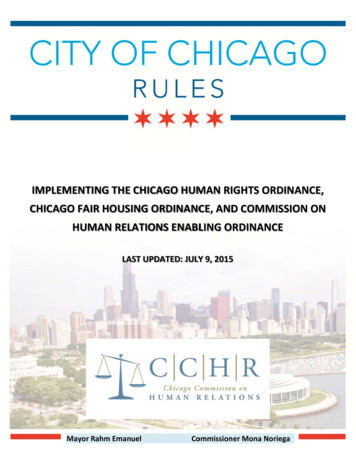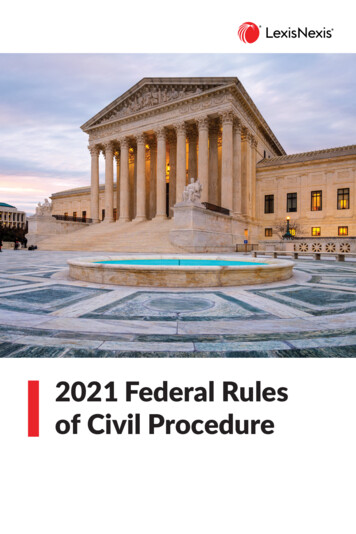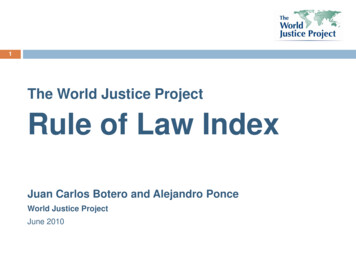
Transcription
1The World Justice ProjectRule of Law IndexJuan Carlos Botero and Alejandro PonceWorld Justice ProjectJune 2010
Basic Premises and Principles2 The World Justice Project is based on two premises:1.The Rule of Law is the foundation for communities ofopportunity and equity.2.Multidisciplinary collaboration is the most effectiveway to advance the Rule of Law.
WJP definition of Rule of Law3 Based on four principles:I.Accountable governmentII.Good lawsIII.Good processIV.Access to justice
The World Justice Project4 Governance structure Financial supporters Activities: Mainstreaming (World Justice Forum; Opportunity Fund) Scholarship Rule of Law Index
Multidisciplinary Sponsors5World Federation of Public Health AssociationsU.S. Chamber of CommerceUnion Internationale Des AvocatsTransparency International – USAPeople to People InternationalNorwegian Bar AssociationNational Association of Medical Minority EducatorsKaramah: Muslim Women Lawyers for Human RightsInternational Trade Union ConfederationInternational Organization of EmployersInternational Institute for Applied Systems AnalysisInternational Chamber of CommerceInternational Bar AssociationInter-Pacific Bar AssociationInter-American Bar AssociationHuman Rights WatchHuman Rights FirstClub of MadridCanadian Bar AssociationAssociation of International Educators (NAFSA)American Society of Civil EngineersAmerican Public Health AssociationAmerican Bar Association17 DisciplinesArchitectureThe vernmentHuman RightsJudiciaryLaborLawMediaMilitaryPublic HealthPublic Safety & LawEnforcementScience
The Rule of Law Index6 The Rule of Law Index is a work in progress 3 years of intensive development, worldwide consultation,“beta testing” and review by over 1000 experts andpractitioners Index 1.0 – Pilot in 6 countries (2008) Index 2.0 – Testing in 35 countries (2009) Index 3.0 – Report for 35 countries (2010)Index international advisory board
The Rule of Law Index7 The ROL Index is a quantitative assessment tool designed tooffer a comprehensive picture of the extent to which countriesadhere to the rule of law. Contribution:1) Comprehensive definition of Rule of Law2) New data: Views and experiences of ordinary peopleViews and opinions of experts3) “Translation” of the abstract concept of Rule of Law into outcomeindicators based on more than 700 questions The scores of the Index can be interpreted as degrees ofcompliance of a legal system to a definition of Rule of Law.
The Rule of Law Index8 A project of this nature faces 5 challenges:1. Definition: What is Rule of Law?2. Measurement: How can we measure validly and reliably Rule of Lawoutcomes?3. Summarization: How can we summarize the information intomeaningful indicators?4. Acknowledgement of limitations5. Data presentation and Inferences
What is rule of law?“Thin” definitionFormalproceduralrules “Thick” definitionEffectiveaccess tojusticeDemocraticelectionsThe Index takes an intermediate position that encompasseselements of political participation, fundamental human rights,and access to justice.
WJP Rule of Law Index 3.010 Sub-Indices - DRAFT1. Limited Government Powers2. Corruption3. Clear, Publicized and Stable Laws4. Order and Security5. Fundamental Rights6. Open Government7. Regulatory Enforcement8. Access to Civil Justice9. Effective Criminal Justice10. Informal Justice
WJP Rule of Law Index 3.09.1 Criminal investigation system is timelyand effective9.2 Criminal adjudication system is timelyand effective9. Effective criminaljustice9.3 Criminal system is impartial and free ofimproper influence9.4 Due process of law and rights of theaccused- Detention- Torture and abusive treatment to suspects- Secret trial- Legal representation- Rights of prisoners
WJP Rule of Law Index 3.012 10 self-contained Indices [Partial overlap] Example 1: A free press is both a manifestation of aFundamental Right in action (free speech), and a nongovernmental check on the government’s powers (checksand balances/accountability).Limited Government PowersFundamental RightsFreepressNon-governmental check ongovernment’s powerFree speech
Measurement131) Focus on “Effectiveness of law” rather than “Law on books”.2) The WJP Rule of Law Index 3.0 focuses on “outcomes”rather than “inputs”Example 2:Outcome: Homicide rate (Crime)Input: Police resources Useful, but this may or may not be the driving reasonbehind homicide rates The index cannot measure all relevant inputs Focuson outcomes, which are the final goal policymakers wantto address.
Measurement143. Use multiple questions to proxy for abstract concepts Capture concepts which cannot be captured by a single variable Validate resultsExample 3: Concept : Affordability of civil justice How significant are the following barriers for poor people?Court feesExpected cost of hypothetical procedureDescription of actual costs paid by people who used thesystem to enforce a debt contract.Perception of people about court fees
Building indicators and indices15 Summarize information in indices Methodological issues: Missing values Normalization Weighting Aggregation Robustness
WJP Rule of Law Index 3.09.1 Criminal investigation system is timelyand effective9.2 Criminal adjudication system is timelyand effective9. Effective criminaljustice9.3 Criminal system is impartial and free ofimproper influence9.4 Due process of law and rights of theaccused- Detention- Torture and abusive treatment to suspects- Secret trial- Legal representation5questions- Rights of prisoners
Using the Index Data17 The Index has been designed to: Assess countries’ adherence to the rule of law in practice Identify a nation’s strengths and weaknesses in comparisonto similarly situated countries Track changes over timeThe Index acknowledges the important role of “informal”systems of justice for resolving disputes
Acknowledging limitations181) Definition: Different definitions and value structures. Different legal architectures. Uwa community in ColombiaParliamentary democracy, presidential democracy, kingdomDifferent goals. E.g. Criminal system: Retribution and deterrence: USARehabilitation and social harmony: Japan
Acknowledging limitations192) Measurement Cross-cultural differences Sensitive questions Measurement error3) Sampling Rural vs. urban
Data presentation and inferences20 Avoid situations where countries use indicators not as agovernance tool, but as a goal. Be careful with cross-country comparisons and rankings Be careful with linking scores with priorities for reform. Be transparent: Make measures and assumptions as explicitas possible
Example21 Assume you are not feeling well Go to your physician for a generalassessment Check temperature- Check heart rate - Check fatigue - Specialist: Further assessmentTake medicine to get wellIndex
Current statusCountries indexed for 201022
Growth Plan and next steps23 WJP Rule of Law Index Report 2010 (In September)100 Jan20102011DecNovExpansionDec
Example 1: Morocco(Casablanca, Rabat, Fes)24Limited Government Powers0.54Corruption0.47Clear, publicized and stable laws0.41Order and Security0.72Fundamental RightsOpen Government0.560.22Regulatory Enforcement0.47Access to Civil Justice0.55Effective Criminal Justice0.00Bottom ScoreMorocco0.630.200.400.60Top score0.801.00
Example 2: Jordan(Amman, Az Zarqa, Irbid)Access to Justice(Indices 8 and 9)Sub-index 8.2:People canaccess legalcounselSub-index 9.4:Due process oflawSub-index 9.3:Criminal sy stemimpartial andfree of improperinfluence1.000.50Sub-index 8.3:People canaccess andafford civ ilcourtsSub-index 8.4:Civ il justice isimpartial andfree of improperinfluence0.00Sub-index 9.2:Criminaladjudicationtimely andeffectiveSub-index 9.1:Criminalinvestigationtimely andeffectiveSub-index 8.5:Civ il justice isnot subject tounreasonabledelay sSub-index 8.6:Civ il justice iseffectiv elyenforcedSub-index 8.7:ADRs areaccessible, impartial, andeffective
Access to Justice - JapanAccess to Justice(Indices 8 and 9)Sub-index 8.2:People canaccess legalcounselSub-index 9.4:Due process oflawSub-index 9.3:Criminal systemimpartial andfree of improperinfluence1.000.50Sub-index 8.3:People canaccess andafford civilcourtsSub-index 8.4:Civil justice isimpartial andfree of improperinfluence0.00Sub-index 9.2:Criminaladjudicationtimely andeffectiveSub-index 8.5:Civil justice isnot subject tounreasonabledelaysSub-index 9.1:Criminalinvestigationtimely andeffectiveSub-index 8.6:Civil justice iseffectivelyenforcedSub-index 8.7:ADRs areaccessible,impartial, andeffective
Access to Justice – MexicoAccess to Justice(Indices 8 and 9)Sub-index 8.2:People canaccess legalcounselSub-index 9.4:Due process oflawSub-index 9.3:Criminal systemimpartial andfree of improperinfluence1.000.50Sub-index 8.3:People canaccess andafford civilcourtsSub-index 8.4:Civil justice isimpartial andfree of improperinfluence0.00Sub-index 9.2:Criminaladjudicationtimely andeffectiveSub-index 8.5:Civil justice isnot subject tounreasonabledelaysSub-index 9.1:Criminalinvestigationtimely andeffectiveSub-index 8.6:Civil justice iseffectivelyenforcedSub-index 8.7:ADRs areaccessible,impartial, andeffective
Access to Justice – LiberiaAccess to Justice(Indices 8 and 9)Sub-index 8.2:People canaccess legalcounselSub-index 9.4:Due process oflawSub-index 9.3:Criminal systemimpartial andfree of improperinfluence1.000.50Sub-index 8.3:People canaccess andafford civilcourtsSub-index 8.4:Civil justice isimpartial andfree of improperinfluence0.00Sub-index 9.2:Criminaladjudicationtimely andeffectiveSub-index 8.5:Civil justice isnot subject tounreasonabledelaysSub-index 9.1:Criminalinvestigationtimely andeffectiveSub-index 8.6:Civil justice iseffectivelyenforcedSub-index 8.7:ADRs areaccessible,impartial, andeffective
Summary29 Defining and measuring the Rule of Law is complex; howevermeasuring has its benefits. The WJP Rule of Law Index provides a first step by relying ona carefully specified definition of the Rule of Law which isoperationalized into more than 500 questions applied toexperts and random samples of the general population. For more information, please visit:www.worldjusticeproject.org
Thank you30
The culture of the Rule of Law31“To be truly effective the rule of law needs to form part of thelegal and political culture of the country. I cannot stressenough the importance of such a culture, which, if respected,is the greatest protection against injustice. Hence theimportance of mainstreaming emphasized by the WorldJustice Forum Ultimately, the struggle for a better societyis a political struggle. One of the virtues of the rule of law isthat it provides space for such contestation to take place.”Arthur Chaskalson, former Chief Justice of the South AfricanSupreme Court.Remarks at the World Justice Forum I. Vienna, July, 2008.
Costs: Formal and Informal Justice32Costs Formal Vs. InformalDispute Settlement Systems10.90.8Formal ormal (Traditional) Justice0.70.80.91
Costs: Formal and Informal Justice33Costs Formal Vs. InformalDispute Settlement Systems10.90.8Formal Courts0.70.60.50.40.3Informal Justiceappears to be lesscostly in most cases0.20.1000.10.20.30.40.50.6Informal (Traditional) Justice0.70.80.91
Food for thought 341.000.90Ethnic .000.000.100.200.300.400.500.600.70Violence by the Police and Military0.800.901.00
FractionalizationEthnic 0.100.090.060.010.0060,000.050,000.040,000.0GDP Per CapitaLiberiaKenyaNigeriaSouth andColombiaJordanMexicoUSAMoroccoDom. gentinaPhilippinesAlbaniaEl SalvadorPolandAustriaNetherlandsFranceAustraliaSw edenJapanSouth 400.500.600.700.800.90Ethnic FractionalizationFractionalization. Alesina et al - Journal ofEconomic Growth, vol. 8, no. 2, June 2003,pp. 155-194.1.00
“Thick” v. “Thin”36 Pros and cons: “Thin” definitions may be more readily applicable to diversesocial and political systems. But a system of positive law that fails to respectinternationally recognized norms is at best “rule by law,”not “rule of law.” The Index takes an intermediate position that encompasseselements of political participation, fundamental human rights,and access to justice.
What is rule of law?“Thin” definitionFormalproceduralrules“Thick” er thelawEffectiveaccess tojusticeOrder andsecurityEffectiveprotection ofcivil andpolitical rightsSeparationof powersEffectiveprotection ofsocial nmentregulation
Measurement384. Triangulation [Cross-checking data using multiple sources] Observers: Two main sources of new data: A general population poll: Probabilistic sample: 1,000respondents per country (three largest cities). Qualified respondent’s questionnaires: Completedby in-country experts in civil and commercial law;criminal justice; labor law; and public health. Measurement tools: Three types of questions General perception questionsHypothetical cases with standardized assumptionsExperienced based questions
MeasurementExample 4: Sub-index 4.3: People do not resort to violence to redresspersonal grievancesTriangulation of observers Mob justice Triangulation ofmeasures People’s perception / Experts’ perceptionPlease assume that a criminal is apprehended by theneighbors after committing a serious crime. How likelyare the following outcomes?:a) The criminal is beaten by the neighborsb) The criminal is turned over to the authorities withoutharmPeople’s experienceDuring the last year, have you seen a criminal beingbeaten by the people in this neighborhood?
40During the last three years, have you or someone in your householdbeen unfairly subjected to physical abuse by the police or themilitary? (Percentage of people answering sia
41Q3A1.000.900.800.70y 0.919x - 0.0159R² 0.801.00
42Q4E1.000.900.800.700.600.500.400.30y 0.8159x 0.1799R² 0.79070.200.100.000.000.200.400.600.801.00
9. Effective criminal justice WJP Rule of Law Index 3.0 9.1 Criminal investigation system is timely and effective 9.2 Criminal adjudication system is timely and effective 9.3 Criminal system is impartial and free of improper influence 9.4 Due process of law and rights of the accused - Detention - Torture and abusive treatment to suspects .



